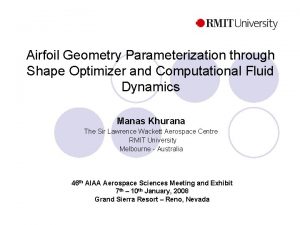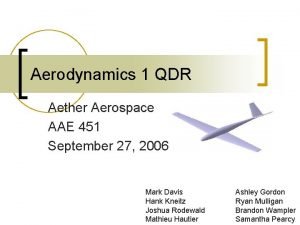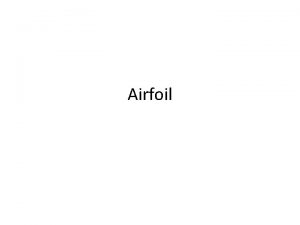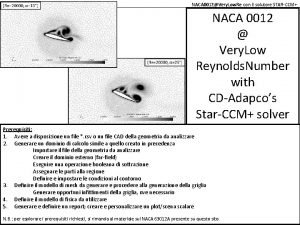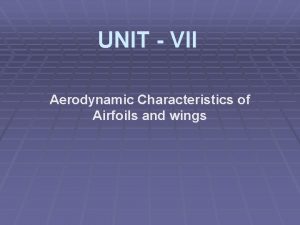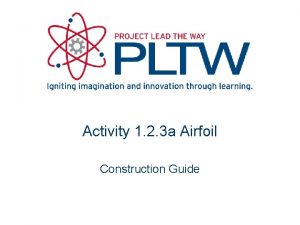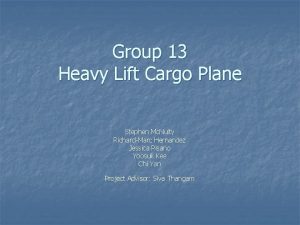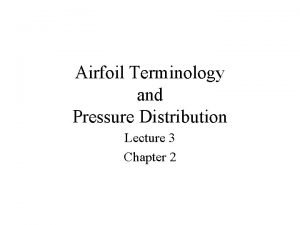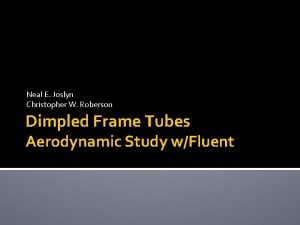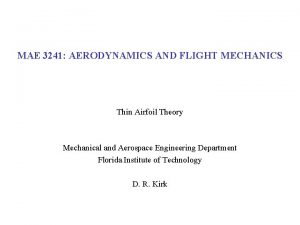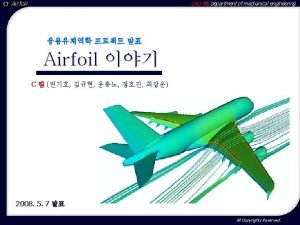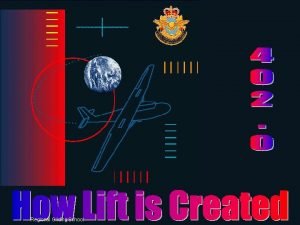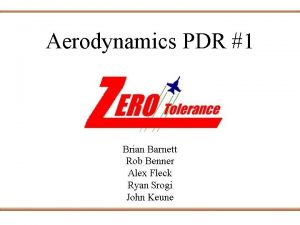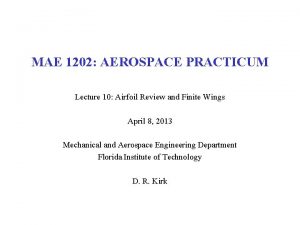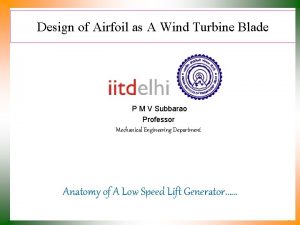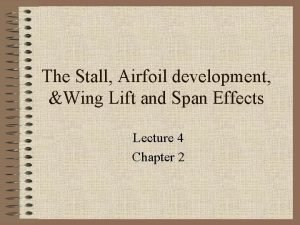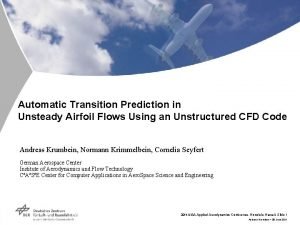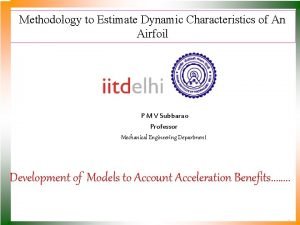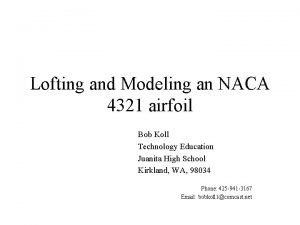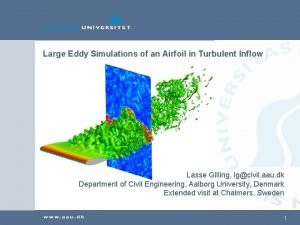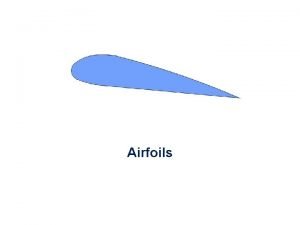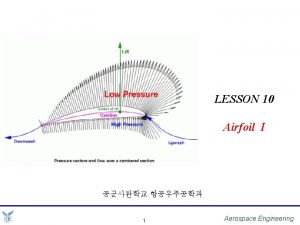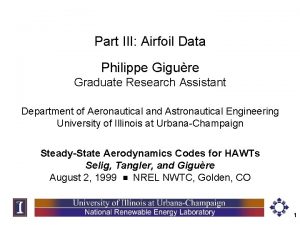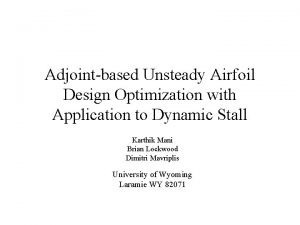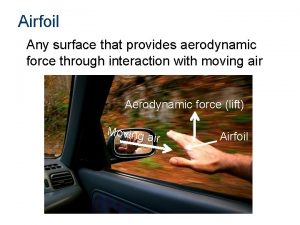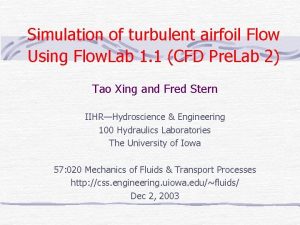4 0 2 0 4 An airfoil or
































- Slides: 32

4 0 2. 0 4

� An airfoil or airfoil section may be defined as any surface designed to obtain lift. It has been found that the most suitable shape for producing lift is a curved or cambered shape.

� The camber is the curvature of the upper and lower surfaces of an airfoil. Usually the upper surface has a greater camber than the lower.

� � When two forces are equal and opposite, the aircraft is said to be in a state of equilibrium. Therefore, when thrust and drag are equal and opposite, the aircraft will continue to move forward at the same uniform rate of speed. Equilibrium refers to steady motion and not to a state of rest. If either of these forces become greater than the force opposing it, the state of equilibrium will be lost.

� � � When lift and weight are equal and opposite, the airplane will be in equilibrium. However, if lift is greater than weight, the airplane will climb. However, if weight is greater than lift, the airplane will sink.

� � � When thrust and drag are equal and opposite, the airplane will be in equilibrium. If thrust is greater than drag, the airplane will accelerate or gain speed. If drag is greater than thrust, the airplane will decelerate or lose speed.

� When two forces are equal and opposite, the airplane is said to be in a state of equilibrium. When two forces such as lift and weight are equal and opposite, but parallel rather than passing through the same point, they are said to form a couple. A couple will cause a turning moment about a given axis (couples act around the C of G).

� If weight is ahead of lift, the couple created will turn the nose of the airplane down.

If lift is ahead of weight, the couple created will turn the nose of the airplane up.

If drag is above thrust, the couple formed will turn the nose of the airplane up.

If thrust is above drag, the couple formed will turn the nose of the airplane down.

NOTE: You must use the buttons in the Confirmation Stage

Theory of Flight How Lift is Created Let's try a few review questions on Theory of Flight: Question #1 - When two forces are equal, opposite and parallel they are said to be a(n). A Couple B Equilibrium C Camber D Airfoil

Flying Scholarship Program I’m afraid that answer is incorrect Let's try again. . .

Flying Scholarship Program That answer is correct. Let's move on. . .

Theory of Flight How Lift is Created Let's try a few review questions on Theory of Flight: Question #2 - If thrust is above drag, how will the aircraft move? A Accelerate B Decelerate C Climb D Descend

Flying Scholarship Program I’m afraid that answer is incorrect Let's try again. . .

Flying Scholarship Program That answer is correct. Let's move on. . .

� � A term used to describe the direction of the airflow with respect to the wing. Relative airflow, also known as relative wind, is created by the motion of the airplane though the air. It is also created by the motion of air past a stationary body or by a combination of both. Therefore, on a take-off roll, an airplane is subject to the relative airflow created by it’s motion along the ground also by the moving mass of air (wind).

� Is a design device by which a body is so shaped that drag is minimized as the body moves forward through the air.

� � When an aircraft banks to make a turn, one aileron is depressed and the other is raised. The down going aileron being depressed into the compressed air flow, causes drag. The up going aileron, moving up into a more streamlined position, causes less drag. The result is a yaw in the opposite direction to which bank is applied.

� The lift and drag of an airfoil depend not only on the angle of attack but also upon: � the shape of the airfoil � the plan area of the airfoil (wing area) = s � the square of the velocity (true airspeed) = V 2 � density of the air = p

� � Hence the lift of the airfoil can be expressed as a formula by: CL*½p. V 2*S And the drag by CD*½p. V 2*S CL = Coefficient of Lift CD = Coefficient of Drag

� Used to express the relation between lift and drag and is obtained by dividing the lift coefficient by the drag coefficient � Reaches its maximum at 0° angle of attack, obtain the most lift for the least amount of drag.

NOTE: You must use the buttons in the Confirmation Stage

Theory of Flight How Lift is Created Let's try a few review questions on Theory of Flight: Question #3 - What name is given to the direction of the airflow with respect to the wing? A Aileron drag B Air pressure C Relative airflow D Drag air

Flying Scholarship Program I’m afraid that answer is incorrect Let's try again. . .

Flying Scholarship Program That answer is correct. Let's move on. . .

Theory of Flight How Lift is Created Let's try a few review questions on Theory of Flight: Question #4 - What is the best lift-drag ratio? A Lift coefficient / drag coefficient B 0° Aof. A C CL = ½p. V 2 S D CD = ½p. V 2 S

Flying Scholarship Program I’m afraid that answer is incorrect Let's try again. . .

Flying Scholarship Program That answer is correct. Let's move on. . .

Theory of Flight How Lift is Created Congratulations!! You have now completed the How Lift is Created lesson of the Theory of Flight Module. Of course, this lesson is always available to you for future reference if required. You are now ready to move along to the next Theory of Flight lesson you have not completed or to any other module you wish. You can advance to the Self Test Module if you feel ready to challenge the final exam. Good Luck!
